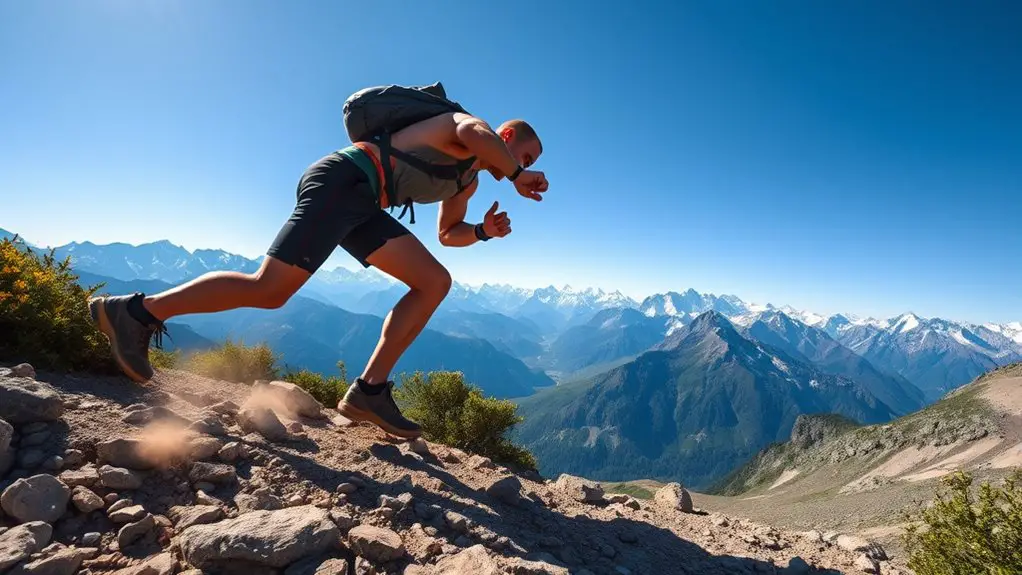To condition your body for mountaineering, focus on building endurance through cardiovascular training like running and cycling. Strength training is also key, targeting your core, legs, and upper body for better climbing performance. Don't forget flexibility and mobility exercises to prevent injuries. Stay hydrated and prioritize recovery with good nutrition and rest. Mental preparation, including visualization techniques and setting goals, is essential too. There's so much more to explore on this journey to peak physical readiness.
Understanding the Physical Demands of Mountaineering
Mountaineering is no walk in the park; it's a physically demanding pursuit that challenges even the fittest adventurers. You'll face steep ascents, rocky terrains, and unpredictable weather, all of which require strength and endurance. Your body needs to adapt to fluctuating altitudes, which can leave you breathless if you're not prepared.
It's not just about physical strength; mental resilience plays a huge role too. You'll need to push through fatigue and discomfort while staying focused on your goal. Balance and agility are essential as well, helping you navigate tricky paths and avoid injury. Incorporating functional strength training into your regimen can significantly enhance your performance in these challenging environments.
Understanding these demands is the first step toward embracing the freedom of the mountains. When you recognize what your body will endure, you can tailor your training, ensuring you're ready to tackle any challenge that comes your way. Get ready to push your limits and discover the exhilaration of conquering the great heights!
Building Endurance Through Cardiovascular Training
To build the endurance you need for mountaineering, incorporating cardiovascular training is essential. You can choose from various aerobic exercises, like running, cycling, or swimming, to boost your stamina. Don't forget the benefits of interval training; it can help improve your performance and endurance more efficiently than steady-state workouts. Additionally, establishing a structured training plan can guide your progress while allowing flexibility to adjust based on how your body feels.
Aerobic Exercise Options
While preparing for the rigors of mountaineering, incorporating aerobic exercises into your routine is essential for building the endurance you'll need on the trails. Choose activities that ignite your spirit and keep you moving, like running, cycling, or swimming. These options get your heart pumping and sustain your energy for those long hikes. If you love being outdoors, consider hiking or brisk walking in nature; it's both invigorating and functional. Aim for at least 150 minutes of moderate aerobic activity each week, spread out to keep things fresh. Remember, the goal is to build a strong foundation that'll support your adventures. Enjoy the freedom that comes with being fit, and let your body thrive in the great outdoors!
Interval Training Benefits
If you're looking to boost your endurance for those demanding mountain trails, incorporating interval training into your routine can be a game changer. This method alternates between high-intensity bursts and periods of lower intensity, pushing your limits while allowing recovery. It's not just about building stamina; it enhances your cardiovascular fitness, helping you tackle steep inclines with ease. You'll notice increased energy levels, allowing you to explore more freely. Plus, interval training can save time, maximizing your workouts without long hours in the gym. As you embrace this dynamic approach, you'll find yourself more prepared for the unpredictable challenges of the mountains. So, lace up those shoes and get ready to conquer those trails with newfound vigor!
Strength Training for Climbing Performance
To excel in mountaineering, you need to focus on strength training that targets key muscle groups. Core stability exercises, upper body strength, and leg power development will enhance your climbing performance. Let's explore how each of these components plays an essential role in your training regimen. Incorporating exercises like squats and deadlifts can significantly improve your overall strength and power, which are crucial for tackling challenging climbs.
Core Stability Exercises
Building a strong core is essential for mountaineering, as it not only enhances your climbing performance but also helps prevent injuries. A stable core allows you to maintain balance on challenging terrain, making each ascent feel more effortless. Start with planks, side planks, and bridges to develop your core muscles. Incorporate dynamic movements like mountain climbers and Russian twists to challenge your stability further. These exercises engage your deep abdominal and lower back muscles, vital for maintaining posture while climbing. Remember, a strong core isn't just about strength; it's about control and endurance. By prioritizing core stability, you're not just training your body—you're embracing the freedom to conquer greater heights with confidence and resilience.
Upper Body Strength
While many focus on lower body strength for mountaineering, upper body strength is equally essential for climbing performance. Your arms, shoulders, and back play vital roles in pulling yourself up and maintaining balance on steep terrains. Incorporate exercises like pull-ups, push-ups, and rows into your routine to build the muscle you need. Don't forget about your grip strength; dead hangs and fingerboard training can enhance your ability to hold onto challenging holds. Aim for a balanced approach, ensuring you strengthen both pushing and pulling muscles. With a solid upper body, you'll feel more confident and free as you tackle those intimidating ascents. Embrace the challenge, and you'll discover that every climb becomes an exhilarating journey.
Leg Power Development
Releasing your climbing potential hinges considerably on developing leg power. Strong legs are your foundation for tackling challenging ascents and traversing rugged terrain. Incorporate exercises like squats, lunges, and step-ups into your routine to build explosive strength. Plyometric drills, such as box jumps, can enhance your power and agility, letting you leap over obstacles with ease. Don't forget to focus on your calves—strong calves give you the endurance needed for those long climbs. Aim for compound movements that engage multiple muscle groups, making your workouts efficient. Remember, it's not just about strength; it's about control and balance too. By dedicating time to leg power development, you'll feel the freedom of conquering new heights and exploring the great outdoors.
Flexibility and Mobility Exercises for Injury Prevention
To prevent injuries during mountaineering, incorporating flexibility and mobility exercises into your training routine is essential. These exercises help you maintain a full range of motion, keeping your body agile and ready for the unpredictable nature of the mountains.
Dynamic stretches, like leg swings and arm circles, can warm up your muscles and joints before a climb. After your workout, static stretches such as hamstring and hip flexor stretches cool your body down and promote recovery. Incorporate foam rolling to release tension in tight muscles, enhancing your overall mobility.
Yoga is another excellent option, improving flexibility while fostering mental clarity and focus—key for those challenging ascents. Additionally, enhanced flexibility and mobility can significantly reduce your risk of injuries, allowing you to roam freely and enjoy the breathtaking views without restraint. Remember, the more flexible and mobile you are, the less likely you'll face injuries, allowing you to roam freely and enjoy the breathtaking views without restraint. Prioritize these exercises, and your body will thank you on those adventurous climbs!
The Importance of Core Stability in Mountaineering
When you're out on the mountain, core stability is essential for maintaining your balance and coordination. A strong core not only helps you navigate uneven terrain but also greatly reduces your risk of injury. By focusing on core strength, you can enhance your overall performance and safety while mountaineering. Additionally, a well-conditioned core improves movement efficiency, allowing for more fluid and powerful navigation through challenging landscapes.
Enhances Balance and Coordination
While many skills are essential for mountaineering, enhancing balance and coordination through core stability is perhaps one of the most important. Your core acts as the foundation for nearly every movement, helping you stay upright on rocky terrain or when maneuvering steep inclines. Strengthening your core not only improves your balance but also enhances your ability to make quick adjustments as you traverse challenging landscapes. When you're out there, freedom lies in your ability to move fluidly and confidently. Incorporate exercises like planks, bridges, and rotational movements into your training. As you build core stability, you'll feel more in control, allowing you to fully embrace the wild adventures that await you in the mountains.
Reduces Injury Risk
Core stability plays an essential role in reducing injury risk during mountaineering, as it helps support your spine and maintain proper alignment. When you're traversing rugged terrain, a strong core keeps your body balanced and poised, allowing you to react quickly to unexpected challenges. This stability minimizes excessive strain on joints and muscles, which often leads to injuries. By focusing on core strength through targeted exercises like planks and rotational movements, you'll gain the endurance needed for long climbs. Plus, a stable core enhances your overall performance, giving you the freedom to tackle tougher routes without hesitation. So, invest in your core, and you'll not only reduce injury risk but reveal your true mountaineering potential.
Nutrition Fundamentals for Climbers
To tackle the challenges of mountaineering, you need to pay close attention to your nutrition. Your body demands high-quality fuel to perform at its best, especially when you're pushing limits on rugged terrain. Focus on a balanced diet rich in carbohydrates, proteins, and healthy fats. Carbs are your go-to energy source, so load up on whole grains, fruits, and veggies. Don't skimp on protein; it helps repair muscles after strenuous climbs. Nuts, seeds, and lean meats are fantastic choices.
It's also essential to include micronutrients—vitamins and minerals that support overall health and energy production. Think leafy greens and colorful fruits. Remember, consistency is key. Eating regular meals and snacks keeps your energy steady, preventing those dreaded energy dips. Staying well-hydrated is equally important, as hydration supports optimal performance during your climbs.
Lastly, listen to your body. If you're feeling drained, it might be time to refuel. A well-nourished body is your ticket to freedom in the mountains!
Hydration Tips for High-Altitude Adventures
Staying hydrated is just as important as fueling your body when preparing for high-altitude adventures. At higher elevations, your body loses moisture faster due to dry air and increased respiration, so it's crucial to drink plenty of water. Aim for at least three liters a day, but listen to your body—if you're thirsty, quench that thirst!
Electrolytes are your friends; consider adding a pinch of salt or using electrolyte tablets to replenish lost minerals. Replenishing electrolytes during endurance activities can enhance your overall performance. Start hydrating days before your trip, and keep a water bottle handy while you trek.
Warm drinks can also be comforting and hydrating in cold conditions. Don't wait until you're parched; sip regularly to maintain ideal hydration levels.
Recovery Techniques to Enhance Performance
While you may focus on training hard for mountaineering, effective recovery techniques are just as essential for enhancing your performance. Prioritize rest days to allow your body to heal and rebuild. Incorporate active recovery, like light hiking or yoga, to keep your muscles engaged without overexerting yourself.
Nutrition plays a key role, so refuel with a balance of carbohydrates, proteins, and healthy fats post-workout to support muscle recovery. Hydration isn't just for training; drink plenty of water to help flush out toxins and reduce fatigue. Additionally, hydration strategies for recovery such as consuming electrolytes after intense workouts can greatly aid muscle repair.
Don't overlook the power of sleep; aim for 7-9 hours each night to promote overall recovery. Stretching and foam rolling can alleviate muscle tension, improving flexibility and reducing soreness.
Mental Preparation and Visualization Strategies
Recovery isn't just about physical rest; mental preparation plays a significant role in your overall performance. To conquer the mountains, you need a sharp mind. Visualization can be a powerful tool—imagine each step you'll take, the wind against your face, and the summit in sight. This mental rehearsal strengthens your confidence and helps you tackle challenges with clarity. Additionally, integrating stress reduction techniques can further enhance your ability to perform under pressure.
Here's a quick guide to effective mental strategies:
| Technique | Purpose | Benefits |
|---|---|---|
| Visualization | Focus on the journey | Boosts confidence |
| Positive Affirmations | Reinforce self-belief | Reduces anxiety |
| Mindfulness | Stay present | Enhances decision-making |
| Goal Setting | Define your path | Increases motivation |
| Breathing Exercises | Calm your nerves | Improves focus |
Incorporate these strategies into your routine, and you'll find freedom in both mind and body as you prepare to face the wild.
Designing a Customized Training Plan
To effectively prepare for mountaineering, you need a training plan tailored to your unique goals and fitness level. Start by evaluating your current fitness. Are you focusing on endurance, strength, or flexibility? Consider incorporating a mix of cardio workouts, like running or cycling, to boost your stamina. Don't forget strength training; exercises like squats and deadlifts will enhance your climbing power.
Next, add specific mountaineering skills, such as hiking with a weighted backpack. Gradually increase your intensity and duration to mimic the demands of your climbs. Flexibility is key, so include yoga or stretching routines to prevent injuries.
Finally, listen to your body. Adapt your plan as needed, ensuring you're not just pushing limits but also enjoying the journey. The freedom of the mountains awaits, so embrace the process of conditioning yourself for the adventure ahead!
Frequently Asked Questions
What Gear Should I Invest in for Mountaineering Training?
When you're gearing up for mountaineering training, invest in quality footwear, a sturdy backpack, and versatile clothing. Don't forget essentials like hydration systems and trekking poles; they'll enhance your experience and keep you comfortable on your adventures.
How Does Altitude Affect Physical Training for Mountaineering?
Altitude can be a cruel teacher, testing your limits. It decreases oxygen levels, forcing your body to adapt. You'll need to build endurance and strength to conquer those heights, embracing the freedom that awaits.
Can I Train for Mountaineering at Home?
Absolutely, you can train for mountaineering at home! Focus on strength, endurance, and flexibility. Utilize bodyweight exercises, resistance bands, and cardio workouts. Get creative with your space, and don't forget to incorporate some outdoor activities!
What Common Injuries Should I Prepare for in Mountaineering?
When you're preparing for mountaineering, watch out for common injuries like sprains, strains, and blisters. Strengthening your muscles and improving flexibility can help reduce these risks, so you can enjoy the freedom of the climb.
How Long Should I Train Before Attempting My First Climb?
Just like a bird needs time to strengthen its wings before soaring, you should ideally train for at least three to six months. This'll prepare your body and spirit for the freedom of your first climb.




